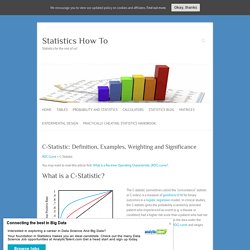

Neural Stats. Single Subject Stat Design in Medicine. The statistical mechanics of human weight change. Measuring change. There is a lot of interest in measuring change in all sorts of areas: Am I losing weight?
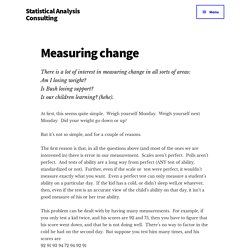
Is Bush losing support? Is our children learning? (hehe). At first, this seems quite simple. Weigh yourself Monday. But it’s not so simple, and for a couple of reasons. The first reason is that, in all the questions above (and most of the ones we are interested in) there is error in our measurement. This problem can be dealt with by having many measurements. Now you can see that the 72 is some kind of mistake. The second problem is that many of the common methods for measuring change make assumptions about the data that are completely unrealistic. There are a number of good books on this sort of analysis, but to my mind, one of the best and clearest is longitudinal data analysis by Donald Hedeker and Robert Gibbons. If you DO have some statistics background, but want to learn more about longitudinal studies, I highly recommend the Hedeker and Gibbons book Well…..there’s one more preliminary.
OK. Overview of Single-Subject Research – Research Methods in Psychology. Explain what single-subject research is, including how it differs from other types of psychological research.Explain what case studies are, including some of their strengths and weaknesses.Explain who uses single-subject research and why.
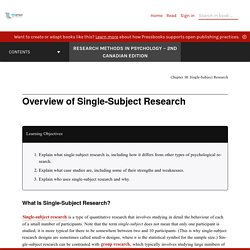
Before continuing, it is important to distinguish single-subject research from two other approaches, both of which involve studying in detail a small number of participants. One is qualitative research, which focuses on understanding people’s subjective experience by collecting relatively unstructured data (e.g., detailed interviews) and analyzing those data using narrative rather than quantitative techniques. Single-subject research, in contrast, focuses on understanding objective behaviour through experimental manipulation and control, collecting highly structured data, and analyzing those data quantitatively. Type your textbox content here. But according to Freud, a breakthrough came one day while Anna was under hypnosis. Media Attributions. Single-Subject Research Design - Education - Oxford Bibliographies.
First described by Murray Sidman in 1960 (Sidman 1960) to study behavioral principles within psychology and then later expanded to become a central element of applied behavior analysis (Baer, et al. 1968; Baer, et al. 1987; Cooper, et al. 2007), single-subject research is used across several disciplines including special and general education, social work, communication sciences, and rehabilitative therapies.

Horner and colleagues report that more than forty-five scholarly journals accept and publish single-subject research studies (Horner, et al. 2005). See also Campbell and Stanley 1963, Kazdin and Tuma 1982, and Kratochwill and Levin 1992. Baer, Donald M., Montrose M. Wolf, and Todd R. Risley. 1968. Statistical considerations in the use and analysis of single-subject designs. - PubMed - NCBI. I. Using the Bland–Altman method to measure agreement with repeated measures. We use cookies to enhance your experience on our website.By continuing to use our website, you are agreeing to our use of cookies.

You can change your cookie settings at any time. <a href=" Find out more</a> Skip to Main Content Sign In Register Close Advanced Search Article Navigation. Analysis of neural firing rates over time. Reliable Analysis of Single-Unit Recordings from the Human Brain under Noisy Conditions: Tracking Neurons over Hours. Special Article: Repeated Measures Designs and Analysis of Longitudinal Data: If at First You Do Not Succeed—Try, Try Again. Single-Subject Experimental Design: An Overview. We use cookies to offer you a better browsing experience, analyze site traffic, personalize content, and serve targeted advertisements.

If you continue to use this site, you consent to the use of cookies. Read about how we use cookies and how you can control them by visiting our Cookie Statement. Facebook Twitter Youtube Pinterest CREd Library, Research Design and Method Single-Subject Experimental Design: An Overview CREd Library, Julie Wambaugh, and Ralf Schlosser December, 2014. Overview of Single-Subject Research – Research Methods in Psychology. Educational Research Basics by Del Siegle. “Single subject research (also known as single case experiments) is popular in the fields of special education and counseling.
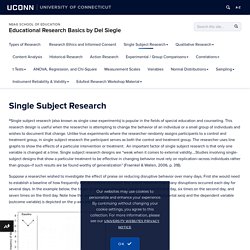
This research design is useful when the researcher is attempting to change the behavior of an individual or a small group of individuals and wishes to document that change. Unlike true experiments where the researcher randomly assigns participants to a control and treatment group, in single subject research the participant serves as both the control and treatment group. The researcher uses line graphs to show the effects of a particular intervention or treatment. Statistics with n=2 - FAQ 591 - GraphPad. Which statistical calculations are valid when you only have two values in each group?
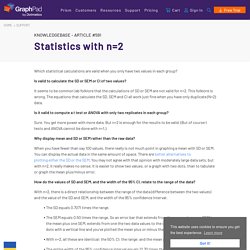
Is valid to calculate the SD or SEM or CI of two values? It seems to be common lab folklore that the calculations of SD or SEM are not valid for n=2. This folklore is wrong. The equations that calculate the SD, SEM and CI all work just fine when you have only duplicate (N=2) data. Is it valid to compute a t test or ANOVA with only two replicates in each group? Sure. Why display mean and SD or SEM rather than the raw data? When you have fewer than say 100 values, there really is not much point in graphing a mean with SD or SEM.
Behavior analysis reaction time one participant. How to Use Excel-Analyzing Single Subject Design Data-Celeration Line and 2 SD Band. How to Use Excel-Analyzing Single Subject Design Data-The C Statistic. How to Use Excel-Analyzing Single Subject Design Data-Statistical Process Control. Statistical Analysis for Single Subject Research Designs. Statistical Analysis and Single-Subject Designs. 4821cf125cbacafd1474d464d8ba49fbd096. Single-Subject Research Designs – Research Methods in Psychology. Describe the basic elements of a single-subject research design.Design simple single-subject studies using reversal and multiple-baseline designs.Explain how single-subject research designs address the issue of internal validity.Interpret the results of simple single-subject studies based on the visual inspection of graphed data.
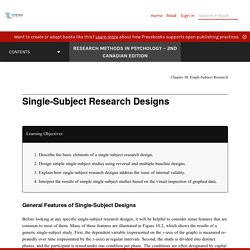
Before looking at any specific single-subject research designs, it will be helpful to consider some features that are common to most of them. Many of these features are illustrated in Figure 10.2, which shows the results of a generic single-subject study. First, the dependent variable (represented on the y-axis of the graph) is measured repeatedly over time (represented by the x-axis) at regular intervals. Second, the study is divided into distinct phases, and the participant is tested under one condition per phase. The conditions are often designated by capital letters: A, B, C, and so on. The study by Hall and his colleagues was an ABAB reversal design. Stats for studies of one person. C-Statistic: Definition, Examples, Weighting and Significance - Statistics How To.
ROC Curve > C-Statistic You may want to read this article first: What is a Receiver Operating Characteristic (ROC) curve?.
